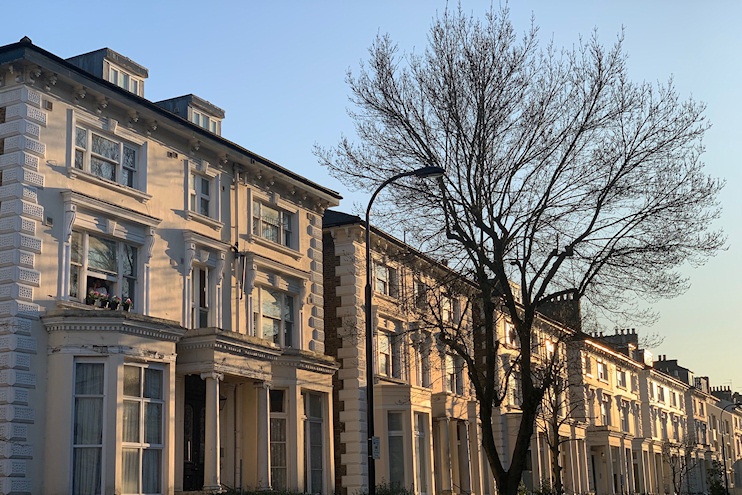Belsize Park
Belsize Park, Camden
A (relatively) poor man’s Hampstead, situated to its south-east

The sub-manor of Belsize was first recorded in the early 14th century and Belsize House in 1496. The name derives from Bel-assis, meaning ‘beautifully situated’.
Well-to-do Londoners built country houses in Belsize in the 17th century, each with its own spacious grounds. Among these was a rebuilt Belsize House, where a sub-lessee who called himself ‘the Welsh ambassador’ opened pleasure gardens in 1720. These briefly attracted high-class visitors, including the Prince and Princess of Wales, but like almost all London pleasure gardens they soon descended into bawdiness and vulgarity, offering entertainments such as mud-wrestling and illegal gaming. The gardens were closed in 1740.
Belsize was divided into nine leasehold estates in 1808, each based on a single house and its parkland. Early exploitation of the leases was limited to the construction of a handful of lodges and villas, while a new and exceptionally grand Belsize House appeared. Terraces of houses were built north of England’s Lane in the mid-1820s but the main phase of suburbanisation came after 1850. One by one the country houses were demolished and their grounds covered with detached or semi-detached houses.
Each development was given the name of the house it replaced, such as the Rosslyn Grove estate and the Hillfield estate, but the largest was the Belsize Park estate on the site of Belsize House, which ultimately gave its name to the entire suburb. Sussex builder Daniel Tidey was responsible for the first stage of Belsize Park’s development, putting up five-storeyed stuccoed houses, but he over-extended himself and went bankrupt in 1869. William Willett and his son, also William, led the next phase, preferring a variety of red-brick designs. Separate ‘village centres’ evolved on England’s Lane and Haverstock Hill and at Belsize Village.
Flats came very early to Belsize Park, built privately from the 1880s and by Hampstead council after 1905. Belsize Park tube station opened on Haverstock Hill in June 1907.
In the 1930s refugees from central Europe opened a synagogue, a Viennese theatre club and continental-style cafés. Flat-building reached a crescendo around this time, when many Victorian properties were replaced. The most impressive of the blocks was the Isokon building on Lawn Road, by the modernist architect Wells Coates. Shown in the Modern House’s photo below, the grade I listed Lawn Road Flats were restored in 2004.
Throughout its existence Belsize Park has acted as a more affordable alternative to Hampstead but the price distinction is less and less apparent nowadays. Most residents rent or own flats in subdivided houses rather than occupying the whole property, although gentrification since the 1970s has resulted in the reunification of a number of homes – for which prices in the millions are the norm.
Such is Belsize Park’s contemporary cachet that estate agents have invented ‘Lower Belsize Park’ as the new identity for the area that had been called Maitland Park for the previous 150 years. For a while, Google Maps went along with this charade.
Belsize Park has always attracted artists, writers and entertainers. The artist Robert Bevan lived locally and painted several views of the neighbourhood, including A Street Scene in Belsize Park (1917), which shows the influence of his acquaintance Paul Gauguin.
Other residents have included the composer Frederick Delius, authors Jerome K Jerome, Nicholas Monsarrat and Agatha Christie, actors Sadie Frost, Jude Law, Hugh Laurie, Kate Winslet, Tom Hiddleston and Helena Bonham-Carter, film director Tim Burton and humorists David Baddiel and Frank Skinner.

